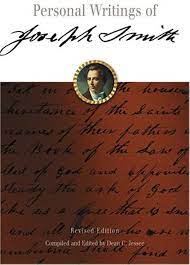Articles/Essays – Volume 22, No. 2
A Prophet’s Progress | Dean C. Jessee, ed., The Personal Writings of Joseph Smith, and Scott R. Faulring, An American Prophet’s Record: The Diaries and Journals of Joseph Smith
No one today knows more about the handwriting, letters, and other documents produced by Joseph Smith, Jr., than Dean C. Jessee. Long a careful student of these primary resources, his comprehensive editing of the Prophet’s writings demonstrates his expertise on virtually every page. The Personal Writings of Joseph Smith, there fore, is a landmark publication. Scott R. Faulring’s editing of the diaries and journals of Joseph Smith also makes a significant contribution to the field. These two fine publications clearly contain the best work of this type, and both deserve a place on the bookshelf of any serious student of early Mormon history and its founding prophet.
Dean Jessee originally planned to publish all significant holographs, those documents produced wholly by Joseph Smith, Jr., with the exception of a few mundane business and administrative writings and his sacred writings. As his work progressed, however, Jessee expanded his scope to include dictated or copied documents that revealed the inner man, even though they were in the handwriting of others. The documents published in The Personal Writings of Joseph Smith have been arranged in two major sections, both presented chronologically: the first contains diaries and autobiographical accounts that Smith was intimately involved in preparing, and the second makes available Smith’s letters.
Jessee’s work is a model of historical scholarship; all documents have been transcribed with original spelling, punctuation, and capitalization and annotated to provide additional background information. Jessee includes facsimile reproductions of many of the most important documents as well. Un fortunately, with the increasingly restrictive policies of the LDS Historical Department Archives, where most of Smith’s papers are housed, this work may be as close as most historians can now come to working with the original documentary evidence of the life of the founding prophet.
One caution is in order in using this edition of Jessee’s book. No one realized when the book was published that no fewer than five of the letters included are in reality the personal writings of Mark Hofmann. These include the earliest document, the Anthon Transcript of 1928; the latest letter, a harried plea for help to Jonathan Dunham dated the day of the Prophet’s death; an 1838 money-digging letter to Hyrum Smith; a June 1844 letter to Maria and Sarah Lawrence revealing a Smith desperately seeking a way for these two plural wives to meet him in hiding; and the 1844 Joseph Smith III blessing. A revised edition of Jessee’s book entitled the Papers of Joseph Smith will be avail able from Deseret Book Company in August 1989.
Faulring’s edition of Smith’s diaries and journals reflects the recent restrictions on the use of materials in the LDS depository. Published in 1987, three years after Jessee’s work, the editor noted in his preface that he “was not allowed access to the originals of any of the documents, all of which are currently housed in the archives of the Historical Department, Church of Jesus Christ of Latter-day Saints” (p. xv). Accordingly, Faulring was forced to work from photomechanical copies held in other depositories. The rationale for this restrictive policy eludes all but the most myopic of Church bureaucrats and, with copies available elsewhere, is essentially “locking the barn door after horse has escaped.”
Faulring’s work contains eleven major documents relating to the life of Joseph Smith. The first is an 1832 autobiographi cal sketch. Following are ten diaries and journals: (1) the “Joseph Smith, Jr., Record Book” covering the years 1832-34; (2) the “Sketch Book for the use of Joseph Smith, Jr.,” 1835-36; (3) the “Scriptory Book of Joseph Smith, Jr.,” for March September 1838; (4) the “Joseph Smith Journal” for 1838-39; (5) the “Minute Book, 1839. J. Smith Journal”; (6) the biographical materials in “The Book of the Law of the Lord,” 1841-43; and (7-10) four untitled journals from 1843-44 kept by Willard Richards. Faulring presents an honest representation of these documents, but he assumes enough editorial license to modernize spellings and word usage.
There is some overlap between the autobiographical writings in Jessee’s work and the diaries and journals in Faulring’s publication. The 1832 autobiographical sketch and the 1832-34 and 1835-36 diaries appear in both works; Jessee exactly duplicates the original, and Faulring standardizes some punctuation and spelling.
In spite of inherent difficulties, both Dean Jessee and Scott Faulring have produced fine books, which make readily avail able critical documentary evidence. Both are important additions to the literature of early Mormonism and will be standard works for years to come.
The Personal Writings of Joseph Smith edited by Dean C. Jessee (Salt Lake City: Deseret Book Co., 1984), v, 736 pp., $18.95.
An American Prophet’s Record: The Diaries and Journals of Joseph Smith edited by Scott R. Faulring (Salt Lake City: Sig nature Books in association with Smith Research Associates, 1987), vii, 504 pp., $50.00.


 Back to full Issue
Back to full Issue

